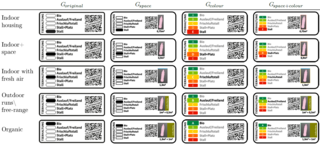Research
How much is the (labelled) pig?
The German Minister of Food and Agriculture has initiated a mandatory state label for animal husbandry, revealing the conditions under which animals are kept. The overarching goal is better husbandry conditions for farm animals. Better conditions will cost more, and it is unclear who will pay the extra price. This study investigates consumers' preferences and their willingness to pay a price premium for pork depending on the different husbandry conditions indicated by the label. If consumers were willing to pay more, farmers who convert their barns and have higher costs for animal husbandry could expect additional income.
The originally planned label, a reductive monochrome multi-level label, and three modifications of it were tested:
- with additional animal-husbandry-specific information on the label levels:
the main criterion for the husbandry levels is the space available to each animal. First, mandatory animal husbandry labelling is introduced for fresh meat obtained from fattening pigs. In the law there are precise details as to which pig weight class is entitled to how many square metres of floor space and how large any outdoor space must be. We have added the square metres for the label levels and a visualisation of the (over 50kg - 110kg) pig in a barn of this size.
- with additional interpretive information: here, colours were used indicating how each of the five animal husbandry levels can be evaluated. The colours are borrowed from the Nutri-Score label and are therefore already familiar to consumers.
- with a combination of both additional information layers.
In the study, data were obtained from a representative (by age and gender) online survey in Germany, only pork eaters (18+ years) were interviewed. The sample size was n=2,015.
The willingness to pay - via a discrete choice experiment - was analysed using a random parameter logit model to answer the following research questions:
- How effective is the proposed mandatory state label for animal husbandry? Are respondents willing to pay more for higher animal husbandry standards?
- Does the additional animal-husbandry-specific information increase the effectiveness of the planned mandatory state label for animal husbandry?
- Does the additional information layer with interpretational data, i.e., a color scheme indicating the difference between the different label levels, increase the effectiveness of the planned mandatory state label for animal husbandry?
- How do effectiveness and willingness to pay change when both information layers are added?
Project team
- Birgit Stoltenberg, Senior Researcher, NIM, birgit.stoltenberg@nim.org
- Dr. Vladimir Manewitsch, Senior Researcher, NIM, vladimir.manewitsch@nim.org
- Dr. Matthias Unfried, Head of Behavioral Science, NIM, matthias.unfried@nim.org
Contact

